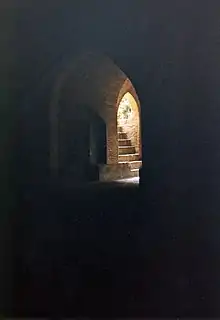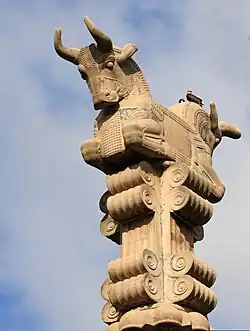
Hashti or Dlan-e-voroudi, in most traditional houses and buildings in Iran, is the space behind the sar-dar (doorway). The term, which is derived from the Iranian word hasht or eight, refers to its design as an octagonal space.[1] However, hashtis are constructed in many different shapes such as hexagonal, square and rectangular designs.[1]
In more luxurious homes, the hashti has more ornamentation and a seating area.[2][3][4] After the hashti, a series of curved and narrow spaces called "rahro" follow, which usually lead to the home's courtyard. In formal buildings such as citadels and shrines, this space can lead to an arched colonnade that forms a ceremonial passageway.[5] In a mosque, the hashti is designed so as to guide the visitor through purification before prayer.[6] The hashti in the Imam Mosque (Shah Mosque) is an example. It leads to the mosque and is constructed next to the Pishkhan, which serves as the entryway that invites people into the building.[7]
The hashti is considered a mediatory space between the gate and the interior spaces of a building.[1] When approached from its relationship with the doorway, the hashti is seen as part of the oscillation between participation and distance, activity, and passivity, and detail and whole, among other related perspectives.[8]
References
- 1 2 3 Shirazi, M. Reza (2018). Contemporary Architecture and Urbanism in Iran: Tradition, Modernity, and the Production of 'Space-in-Between'. Cham, Switzerland: Springer. p. 81. ISBN 978-3-319-72184-2.
- ↑ (Pirniya, 2005).
- ↑ ""Masjed-e-Hakim Hashti or Hallwat"". Archived from the original on 2016-03-04. Retrieved 2014-04-26.
- ↑ ""Ghafouri House, Yazd"" (PDF). Archived (PDF) from the original on 2014-04-26. Retrieved 2014-04-26.
- ↑ Babaie, Sussan (2019). Iran After the Mongols. London: Bloomsbury Publishing. p. 133. ISBN 978-1-78673-601-7.
- ↑ ""HASHTI" Official Website of the Rahgoshay Museum". Archived from the original on 2014-04-26. Retrieved 2014-04-26.
- ↑ "Imam Mosque (Shah Mosque) in Isfahan - Hipersia". hipersia.com. Retrieved 2021-07-08.
- ↑ Fatehrad, Fatehrad Azadeh (2020). ReFocus: The Films of Sohrab Shahid-Saless: Exile, Displacement and the Stateless Moving Image. Edinburgh: Edinburgh University Press. ISBN 978-1-4744-5642-5.
